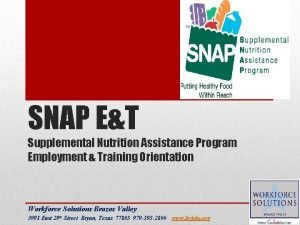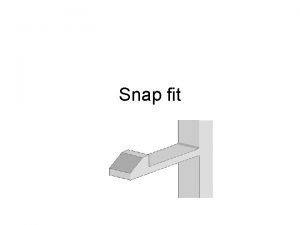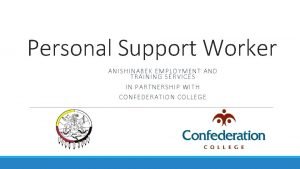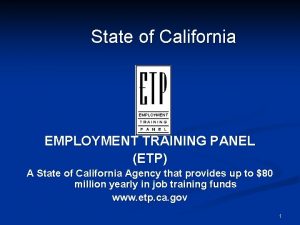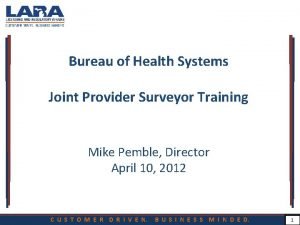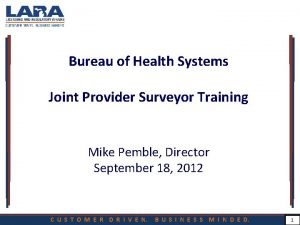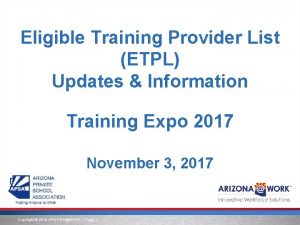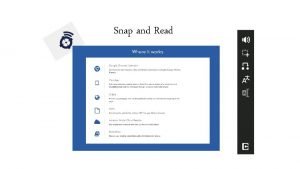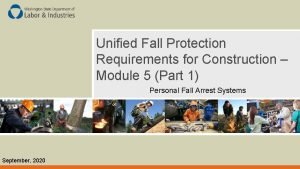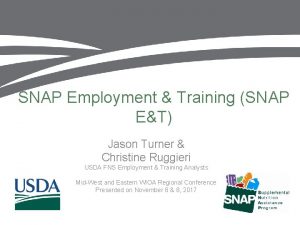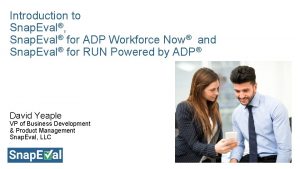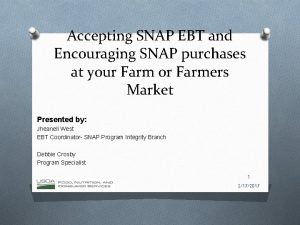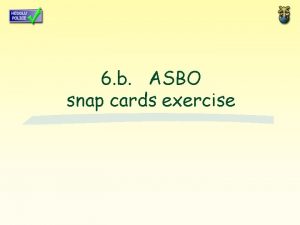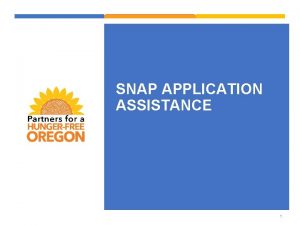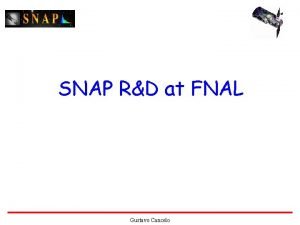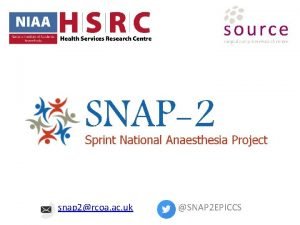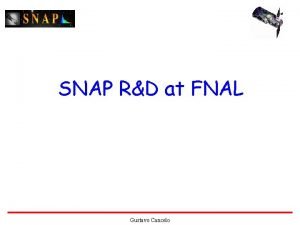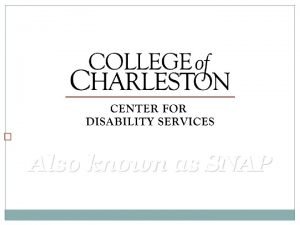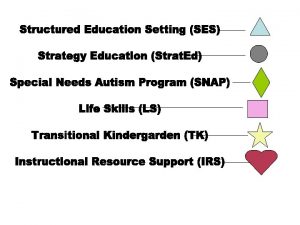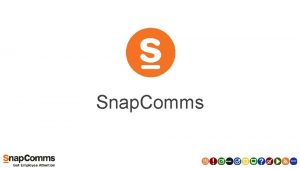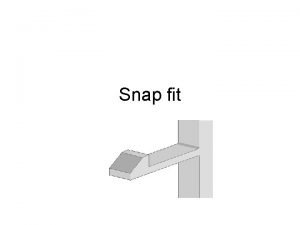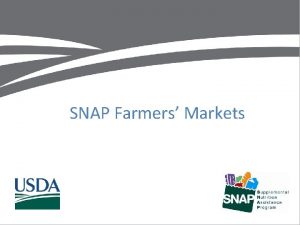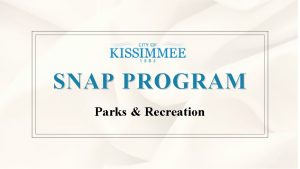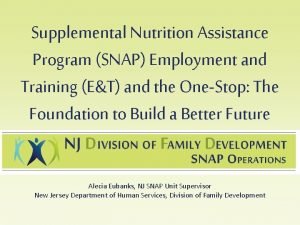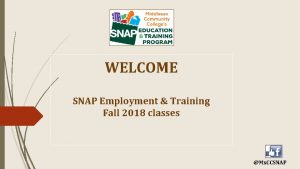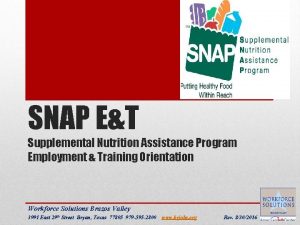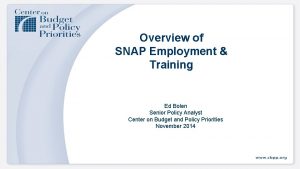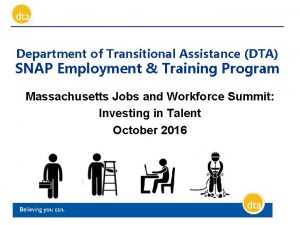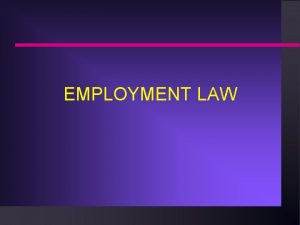SNAP Employment and Training Provider Training Introduction The














































- Slides: 46

SNAP Employment and Training Provider Training

Introduction The State of Arkansas’ vision for improving the quality of life for our most vulnerable citizens includes assisting those in need of finding employment. The Division of County Operations (DCO) is in charge of operating the Employment and Training Program (E&T Program) within Supplemental Nutrition Assistance Program (SNAP), SNAP recipients may volunteer to participate in becoming selfsufficient. Federal Regulations require some Able Bodied Adult without Dependents (ABA) SNAP recipients to register to work and participate in approved activities to maintain eligibility for food assistance. Able Bodied Adults without Dependents who do not meet an exemption can meet the Requirement to Work by volunteering to participate with the E&T Program. Participation in the E&T Program is voluntary, there are no mandatory requirements.

Training Goals To provide guidance on how the SNAP E&T Program operates to assist SNAP recipients with increasing their employability with the goal of becoming self sufficient. To provide hands on training in the data management system (SNAP Works). Acronyms and Terminology DHS – Department of Human Services ABA- Able Bodied Adults DCO- Division of County Operations ( a division within DHS) E&T- Employment and Training SNAP- Supplemental Nutrition Assistance Program SSN- Social Security Number BUID- Budget Unit ID

Who can participate in E&T? Anyone who is receiving SNAP benefits 16 years or older Physically and mentally fit to participate Able to participate immediately Note: Anyone receiving TEA (Transitional Employment Assistance) or Unemployment Insurance (UI) are not eligible for the E&T Program.

Good cause vs. Exemption Good cause includes circumstances beyond the household member’s control, such as, but not limited to illness, household member illness requiring the presence of the member and or household emergency or the unavailability of transportation. The individual is considered to have met the work requirement if the circumstance is temporary and they intend to return to work, including lack of transportation. Good cause will be determined by the county office on a case-by-case basis. Exemptions can be long term and the client does not intend to return to work. An exemption is when SNAP work requirements are waived because a SNAP participant meets a certain criteria. Under the non- compliance tab, the provider will create a good cause task submitted to the county office for review and approval. The county office will determine if the criteria for good cause/ exemption has been met.

Fair Hearings A request for a hearing is defined as any clear expression, oral or written, by the household or a representative that the household wishes to appeal a decision or to present its case to a higher authority. The freedom to make such a request must not be hampered in any way. If the provider receives a request from a client for a fair hearing then they are to create a “Fair Hearing” task in SNAP Works and submit it to the County Office with one business day.

Referrals The SNAP Notice of Work Registration (DCO-260) is an automated system generated notice that is sent to each Able Bodied Adult in the household at the time the case is approved. The DCO-260 advises who in the household is work registered and who is subject to the RTW. E&T referrals occur at certification, recertification and reinstatement of SR cases. Household members with the work participation code “Mandatory – SNAP” and “SNAP E&T Participating” are selected for automated referral. Referrals will be auto-generated to SNAP Works nightly. The provider will need to conduct a search by Referral task each morning to see new referrals.

Monthly notices For every month an able bodied month is used the client will receive a system generated letter from the DHS eligibility system: Month 1 , Month 2, and Month 3. Note The ABA can only receive SNAP benefits for 3 months out of a 36 month period if work requirements are not met).

Referrals If the individual is an Able Bodied Adult, the county office Eligibility Worker will issue the household a PUB-429 which summarizes the RTW and a PUB-427 which explains the criteria for participating in the SNAP E&T program and the services the program offers. Note A client has the option to cross county lines and is not limited to working with the provider in their residence county. Referrals are based on service county.

Referrals If a referral is coded as Mandatory SNAP first confirm their willingness to participate in the E&T program then send a Reverse Referral task to the local county office in order to have their code updated to E&T participating. Add a case note explaining the purpose of the task. For example: “ Client is coded as Mandatory SNAP but would like to participate in E&T. Please update to E&T Participating”. Note The importance of notifying the county office is so that the client will no longer accrue countable months under the Mandatory SNAP participation code. If a referral is coded as E&T participating you can immediately begin working with the client. If the client is otherwise exempt from participating (i. e. Incapacitated Short Term , SNAP Cares for child) but wants to participate in the E&T program a Reverse Referral task needs to be sent to the county office in order to have their General Characteristic updated to Volunteer. Add a case note to explain what needs to be changed by the county staff. Note E&T is not a mandatory program. Arkansas operates a voluntary program , Mandatory SNAP is simply the name of the code.

Assessments & Employment Plans An assessment must completed within 30 days of the referral receipt. A provider should not finalize an assessment until all client scores are keyed. If needed, a provider can save an assessment in order to enter a complete set of scores. Once an assessment is finalized, changes cannot be made. During the assessment the client’s goals, strengths, and barriers should be discussed. The employment plan cannot be created prior to the completion of the assessment. Keep a signed record of the employment plan. ( In the future it will be uploaded in to SNAP Works). Each time a client has a new test score a new assessment must be created.

Participant Types Mandatory SNAP An individual that is able bodied age 18 -49 that meets no other exemptions. The individual must participate in order to receive benefits; approved to receive benefits for up to 3 months unless they meet some type of work requirement in order for benefits to continue. If the client does not comply, the SNAP case will close after 3 months. Must participate a minimum of 80 hours / month. SNAP E&T Participating SNAP recipients that are participating and complying with a SNAP E&T program. This participation code stops the clock from counting towards their 3 months. Must participate a minimum of 80 hours/ month. Volunteer A SNAP recipient who has expressed a desire to participate in E&T but would otherwise be exempt from participating. No monthly participation requirement.

Components Independent Job Search (non-qualifying) Job Search Training (non-qualifying) Vocational Training Occupational Training GED/ Basic Skills/ Literacy ESL OJT/ Apprenticeship Work Experience

Independent Job Search ( searching without relying on someone else) Participant will turn in the following weekly to the provider: Log daily/weekly contacts List company/business name and phone number Participant will check the method of contact Participant will answer job search questions Participant will sign and date form Participant must make at least 3 job search contacts each week. Note Non-qualifying components will only account for Less than 50% of all activities. When assigning a participant one of these components another component must be assigned in conjunction in order for the individual to be considered a full participant.

Job Search Training Develop an employment and training plan after a job skills assessment; Assist in finding financial aid for education; Monitor and report progress Employment counseling, resume building, motivational techniques, job search methods, interview coaching, instructions in a group setting Note Non- qualifying components will only account for less than 50% of all activities done monthly.

Education Educational and remedial programs or activities designed to improve basic skills including literacy, reading and math programs to improve functional levels Assistance in acquiring a high school diploma/equivalency (GED) Assistance to acquire proficiency in the English language Occupational skills training, including but not limited to work keys and selfguided computer-assisted learning programs Short courses (i. e. Certified Nursing Assistant) Post-secondary vocational training (limited to 24 months).

Education: Scholarships The client must have an open SNAP case. A scholarship request form and supporting documentation must be submitted to snapet@dhs. arkansas. gov at least 30 days prior to the program start date. The request should include: Employment plan Assessment Program information ( prices, duration, etc. ) Note Submitting a scholarship request packet does not mean the request is automatically approved.

Work Experience (WEX) Unpaid work at a non-profit or public agency The participant’s obligation of work experience will be calculated by dividing the household’s monthly SNAP allotment (before recoupment) by the current federal or state minimum wage which ever is highest. Always round down. Example: Mary’s SNAP allotment is $192/month. $192/$9= 21. 33 Mary will need to complete 21 hours monthly.

On the Job Training (OJT) Participants receive training on the job, or through an apprenticeship, that provides direct knowledge and / or skills for a specific job. Participants may be hired by a private or public employer and will be paid at the same rate as other employees performing the same or similar jobs. Note The client is not paid when participating in WEX. In OJT the client is paid at the same rate as other employees performing the same or similar job.

Reimbursements Employment and Training participants are eligible for travel reimbursements when complying with program requirements. Maximum amount per month is $50. Reimbursements should be uploaded weekly to SNAP Works for review/ approval by central office staff. Completed documentation required for approval. DCO-243 form and page one of DHS 187 form. A signed receipt/ statement is required if someone provided transportation for the E&T client. Possible reimbursements items: transportation, uniforms, boots, fees , tuition ( when requested by the provider), GED test payments, personal safety items or necessary equipment, training manuals, suitable clothing for interviews, licensing and bonding, background check fees and vision needs. Note Documentation will be required for all reimbursements. Some reimbursements ( i. e. vision needs) will be paid on a case by case basis.

Travel Reimbursement Documents Sections A, B, and C of the DHS-187 must be completed. When the transportation is provided by someone else, documentation of the transportation costs must be attached. Section A: Check Wise Reimbursement box. Clearly write the Client’s first/ last name. Include the full SSN or full BUID. Section B: Full client address. Detailed reason for reimbursement including dates and a dollar amount. Section C: Client or provider signature and date. Official title is either client or E&T provider.

Travel Reimbursement Documents All sections of the DCO-243 must be completed and legible for timely processing. Note: After travel is approved and processed it can take up to 10 business days for the client to receive it. A case note will always be keyed after travel has been approved or denied. Remember to make sure the following are completed prior to travel reimbursement requests: assessment, employment plan and component assignment.

Toast Messages Most common error message - most times the SNAP case is closed.

SNAP Works Tasks Referral tasks come automatically from the DHS eligibility system based on work participation characteristics. Referral tasks will be closed automatically when an appointment is scheduled. Appointment tasks will be automatically created when a provider schedules an appointment and will close automatically when an appointment is marked as “ no show” , “ rescheduled”, or “ show”. Assessment tasks will be automatically created when an appointment is marked as “ show”. The task will close automatically when the assessment is finalized. An assessment task can be closed manually if an assessment cannot be finalized due to non- compliance. Employment plan tasks will be automatically created when an assessment is finalized. The employment plan task will be closed when an employment plan is created. Employment plan tasks can be manually closed if an employment plan cannot be created due to non-compliance. Employment plan annual review tasks are automatically created 10 days from the end of the year if there is an active employment plan. This task should be manually closed after the provider reviews the employment plan.

SNAP Works Tasks Component tasks will be automatically created when an employment plan is created. Component tasks will close when at least one component (linked to an active employment plan) is created. Monthly track component tasks will be automatically created on the 1 st of every month if there was an active component assigned in the previous month. The monthly track component tasks will be closed when all hours and “ met plan” are entered for all components assigned during the previous month. Reimbursement decision tasks are automatically created when a reimbursement decision has been completed. Because the reimbursement decision task is a notification this task will require a manual closure. Client dropped from SNAP case tasks are manually created by a DHS county office staff when a client is dropped from a SNAP case in the eligibility system. The task will close automatically when the case is closed on the enrollment summary page with a reason of “ case closed”.

SNAP Works Tasks Non-compliance decision tasks are automatically created notifications that a decision has been completed. This task can be closed manually. Client no longer RTW tasks are manually created by DHS county office staff if the client is determined to be exempt from participating in E&T. This task will close automatically when the case is closed on the enrollment page with a closure reason of “ client no longer eligible”. Case closure tasks are automatically created when the SNAP cases closes in the eligibility system. This task will automatically close when the case is closed on the enrollment summary page with a closure reason of “ SNAP case closed”. Good cause decision tasks are automatically created notification tasks that a decision has been completed. Because the task is a notification it will require a manual closure. The good cause decision will update the non-compliance page and the components overall progress for the non-compliance month.

Timeline reminders From the date the referral is received, the Provider should schedule the individual’s first appointment within 5 days of the initial contact. If the participant misses the first appointment, a second appointment should be scheduled within the next 10 days. The second appointment should be put in the mail no later than the next business day following the missed appointment. Non- compliance should be reported to the county office within 10 days. To be in compliance with DHS, an assessment must be completed within 30 days of the referral receipt. Once an assessment is finalized, changes cannot be made. The employment plan cannot be created prior to the completion of the assessment. Keep a signed record of the employment plan. ( In the future it will be uploaded in to SNAP Works). Each time a client has a new test score a new assessment must be created.

Reporting Monthly component tracking should be updated in SNAP Works by the 10 th of each month for the previous month. SNAP Works will generate a task for the provider if the client has open components to remind them that they are due. Monthly reports are no longer due on the 10 th of each month, SNAP Works does all of this for you. It is important to build a positive working relationship with your local county office. Please keep the county office staff up to date of any changes with a client by creating a task with detailed narratives. A case note should also be created for documentation purposes.

Scenario 1 ( Component calculations) Jack has chosen to participate in Independent Job Search for 2 hours per week. 3 hours of Job Search equals 6 hours of RTW time. That gives him a total of 24 non-qualifying component hours per month. *Remember this can only account for less than 50% of his hours since this is a non-qualifying component. Jack has decided that he wants to get his GED and will be attending 2 hours weekly. According to the formula each hour of instruction counts as 3 weekly clock hours. Jack will receive a total of 24 qualifying hours for working towards his GED. So far Jack has a total of 48 hours. He needs a total of 80 component hours to meet the requirements. So how many more component hours does Jack need? ( 80 -48= 32) Jack has decided to participate in OJT. According to your training material is OJT a qualifying component? (Yes) One hour of OJT equals one qualifying component hour. So Jack will complete 8 hours per week of OJT to give him his 32 hours. Independent Job Search (non-qualifying) component - 24 hours GED (qualifying) component - 24 hours On the Job Training (OJT) component - 32 hours ************** Total component hours - 80 hours

Scenario 1 continued Looking at Jack’s scenario a little different. What if he was receiving benefit amount of $194 how would we calculate the hours need to complete his Work Experience obligation? Benefit amount of $194 divide by $9 per hour state minimum wage which equals 21. 55. Remember fractions are rounded down so the participant only needs 21 hours Jack chooses to complete 12 hours of Work Experience then he would only need complete 9 additional component hours if he received the benefit amount of $194.

Scenario 2 : household with more than one member Rick and Michone live with their son Carl. Both Rick and Michone are 60 years old so they are exempt from work registration. However, their son Carl is 26 years old and does not meet an exemption according to the exemption tool. The 3 members are included in the same SNAP case. Their monthly benefit amount is $362. If Carl wishes to participate in Work Experience how many hours will he need? 362 divided by 9 = 40. 22 (so Carl needs 40 component hours) If Carl wants to complete 10 hours of work experience each week then he meet the requirements.

Work Experience note If you currently don’t have Work Experience available in your county then nothing will change. However, as the program grows we foresee that the Work Experience component will play a bigger role for providers.

Scenario 3 (Enrollment) Daniel White is an Arkansas resident who is receiving SNAP benefits. He was referred to participate in the E&T program. A Provider picked up Daniel’s referral to contact the client, scheduled an appointment, conducted assessment, and created an employment plan to get the necessary training and skills to gain permanent employment. Log in Assessment Track Component Employment Plan • Log into portal • Review Client Information • Review Assessment • Review Component • View Dashboard • Contact Client • Create Employment Plan • Track Component • Search Tasks • Schedule Appointment / Assessment • Assign Components • Monthly Progress • Finalize Assessment

Scenario 4 ( Good cause) Brittany is an E&T program participant, and is not participating in her components. The Provider contacted the client multiple times and found out that Brittany was in a car accident in October. The Provider decides to request good cause for the month and enters the non-compliance information with detailed notes. Log in • Log into portal • Search Client Review Approval Good Cause • Navigate to Non. Compliance Tab • Complete non-compliance task and good cause request assigned to county office. Fully document in the case note. • Good Cause Decision comes into system for review by provider after a decision has been made by the county office.

Scenario 5 ( Reverse referral) Rennick is an Arkansas resident who is receiving SNAP benefits and is exempt from the E&T program. He talks to his neighbor about the E&T program, and goes to a provider to get more information. A provider discusses the E&T program with Rennick, and Rennick is excited to join. The provider performs a reverse referral to be approved by the County Staff so that Rennick can start participating in the E&T program as a volunteer. Reverse Referral Log in • Log into portal • Review Client Information • Search Universe by SSN • Create Reverse Referral Task Referral • Referral comes into SNAP Works automatically once the county has taken action.

Reverse referral continued If you did a reverse referral and they did not show up after the county took action you can first try to attempt another reverse referral. You should receive the “Red” toast message indicating that the client is already open in SNAP Works. If that happens then send an email with a screen shot to snapet@dhs. arkansas. gov and request the client be assigned to you. We can then go in and reassign the client to the correct provider. Another instance where this may happen is when the client lives in one county but decides to participate with a provider in another county. The reverse referral would first go to the provider in the county of residence. The same procedures would be followed. If they do not show in SNAP Works attempt to do another reverse referral and if you get the red toast message then that is your indication that you need to email to have the client reassigned.

Virtual Services Virtual case management is in rural counties that have been identified as having a low amount of able bodied adults. E&T will provide the DHS county offices in those counties with computer equipment with a camera so that the client can participate in one on one virtual case management with the provider via Web. Ex. The provider will schedule an appointment with the client just like they would a face to face appointment. The client will report to the DHS County Office and County Office Staff will assist the client in joining the online Web. Ex session. During the session the client and provider will have face to face contact so they can complete the initial assessment and employment plan exactly as an in person appointment would take place. The provider will then email documents to the County Office Staff so it can be printed and given to the client to sign. Once any needed documentation is signed the County Office Staff will scan and email it back to the provider. The client will be referred to resources within their community for services just like they would in a normal in person setting.

What would you do? I have a client who has been complying with the program until last month. She called me in the middle of the month and said that her husband's COPD was acting up badly and wanted to know if she could take some time to take care of him. I told her that it would use one of her months, but if that is what she felt like she needed to do it would be fine. She received a letter in the mail from the county office that is she could not provide proof for good cause that her status would be changed to Mandatory. She called me in a panic this morning asking to explain the letter. I tried to explain, but suggested that she call the DHS office since the letter came from them. She has just called me back, but the county office said that she was not allowed to miss any at all. Her status would be changed to Mandatory and that after her 3 months runs out she would lose her food stamps. I guess I just want to know if I am wrong in telling clients that they are able to use a month while they are participating when life circumstances come up. Do I need to, or am I even allowed to re-enroll her? Please advise.

What would you do? I have a question about the required paperwork: for Adult Ed, we use a release of information form for all clients that allows us to speak with law enforcement, judges, mental health professionals, and others involved in our client's lives in order to coordinate services for each individual. If a client refuses to sign the release form due to their conflict with law enforcement, are they in non-compliance?

What would you do? I have a scholarship request for my client to attend CNA courses. What steps do I need to take?

Reminders Remember to use Google Chrome to access SNAP Works. Be sure to disable pop-up blockers in order to print. Central office staff cannot reset user passwords. If you search for a client and get a yellow toast message “ client not found in ANSWER” , it is highly likely that the SNAP case is closed. Only DHS staff including the system coordinator will be able to edit the noncompliance page once the record is created. The pencil icon will only be enabled while a decision is pending. Once a decision is made, the page will be read only for all users. ( page 96 SNAP Works Provider User Guide)

Reminders Clients do not have to sign release of information forms in order to be compliant, this is not a requirement for SNAP E&T. Instructions per tab are explained in detail beginning on page 31 of the provider user guide and go through page 112. Appointment tasks cannot be closed manually. Marking the appointment as show/ no show will close the task. All case management should be documented in the client’s case notes. Please send all questions to snapet@dhs. arkansas. gov. Provide screenshots.

Reminders Unfortunately, there is no cookie cutter answer to every situation. Each case will be looked at on a case by case basis. What we don’t want to do is get in to a cycle where we are constantly sending tasks back and forth to drop the client from the program only to turn around the next month and refer them back in to the program because they have applied again to participate in the SNAP program.

Churn Rate What is churn rate? It is a measure of the number of individuals or items moving out of a collective group over a specific period of time. How does it affect us? If proper case management steps are not applied it means that we will constantly be moving clients in and out of the E&T program and possibly the SNAP program. If left unmanaged that means we will waste our resources moving the clients in and out of the programs rather than providing the supportive services that they need. It is likely to get the same clients over and over again.

E&T coverage

Questions?
 Snap employment and training program texas
Snap employment and training program texas Filing snap fit snap partner maylundentechcrunch
Filing snap fit snap partner maylundentechcrunch Anishinabek employment and training services
Anishinabek employment and training services Gila river employment and training
Gila river employment and training Employment training panel sacramento
Employment training panel sacramento Dcs service providers
Dcs service providers Opito central register
Opito central register Joint provider surveyor training michigan
Joint provider surveyor training michigan Joint provider surveyor training michigan
Joint provider surveyor training michigan Training provider-tnskill.tn.gov.in
Training provider-tnskill.tn.gov.in Etpl
Etpl Snaphead rivet
Snaphead rivet Snapandread
Snapandread Dbi sala
Dbi sala If you are happy
If you are happy Hình ảnh bộ gõ cơ thể búng tay
Hình ảnh bộ gõ cơ thể búng tay Slidetodoc
Slidetodoc Bổ thể
Bổ thể Tỉ lệ cơ thể trẻ em
Tỉ lệ cơ thể trẻ em Voi kéo gỗ như thế nào
Voi kéo gỗ như thế nào Glasgow thang điểm
Glasgow thang điểm Chúa yêu trần thế alleluia
Chúa yêu trần thế alleluia Môn thể thao bắt đầu bằng chữ f
Môn thể thao bắt đầu bằng chữ f Thế nào là hệ số cao nhất
Thế nào là hệ số cao nhất Các châu lục và đại dương trên thế giới
Các châu lục và đại dương trên thế giới Công thức tiính động năng
Công thức tiính động năng Trời xanh đây là của chúng ta thể thơ
Trời xanh đây là của chúng ta thể thơ Cách giải mật thư tọa độ
Cách giải mật thư tọa độ Làm thế nào để 102-1=99
Làm thế nào để 102-1=99 Phản ứng thế ankan
Phản ứng thế ankan Các châu lục và đại dương trên thế giới
Các châu lục và đại dương trên thế giới Thể thơ truyền thống
Thể thơ truyền thống Quá trình desamine hóa có thể tạo ra
Quá trình desamine hóa có thể tạo ra Một số thể thơ truyền thống
Một số thể thơ truyền thống Bàn tay mà dây bẩn
Bàn tay mà dây bẩn Vẽ hình chiếu vuông góc của vật thể sau
Vẽ hình chiếu vuông góc của vật thể sau Nguyên nhân của sự mỏi cơ sinh 8
Nguyên nhân của sự mỏi cơ sinh 8 đặc điểm cơ thể của người tối cổ
đặc điểm cơ thể của người tối cổ Ví dụ về giọng cùng tên
Ví dụ về giọng cùng tên Vẽ hình chiếu đứng bằng cạnh của vật thể
Vẽ hình chiếu đứng bằng cạnh của vật thể Tia chieu sa te
Tia chieu sa te Thẻ vin
Thẻ vin đại từ thay thế
đại từ thay thế điện thế nghỉ
điện thế nghỉ Tư thế ngồi viết
Tư thế ngồi viết Diễn thế sinh thái là
Diễn thế sinh thái là Dạng đột biến một nhiễm là
Dạng đột biến một nhiễm là
